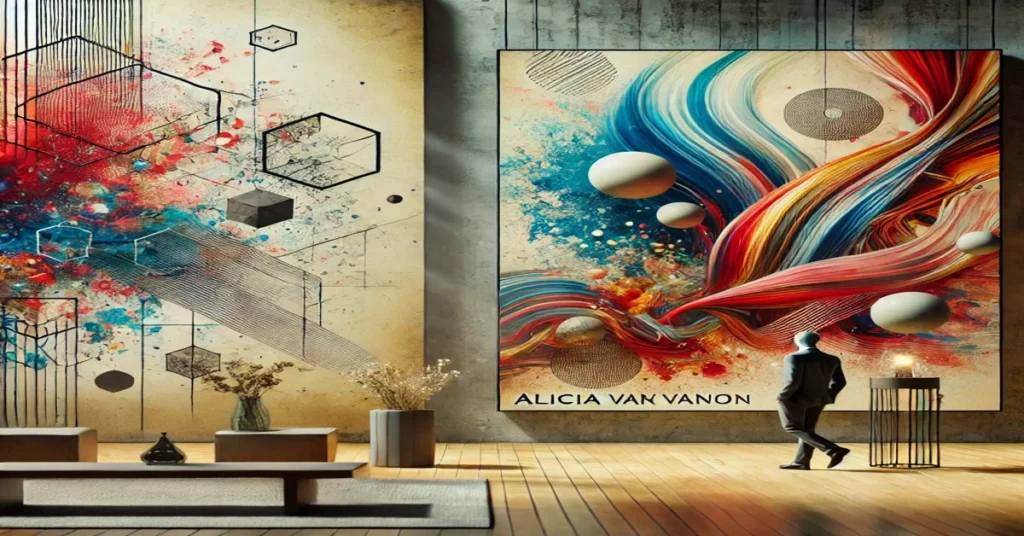Alicia Vancor is a name that has become synonymous with innovation and boundary-pushing in the contemporary art world. With her distinct style and fearless experimentation, Vancor has captured the attention of critics, collectors, and art lovers alike. Her works challenge traditional notions of what art can be, blending mediums, themes, and techniques to create immersive, thought-provoking pieces. But beyond her visual mastery lies a deeper story—a story of an artist who dares to question societal constructs and the nature of human identity.
In this article, we will explore Alicia Vancor’s journey as an artist, her artistic process, and the key themes that define her work. From her early influences to her current impact on contemporary art, Vancor’s story is one of constant evolution and the desire to push beyond conventional limits. Whether you are an avid follower of modern art or someone new to her work, Alicia Vancor’s approach offers a refreshing perspective that inspires reflection, connection, and transformation.
Alicia Vancor: Early Life and Creative Roots
Alicia Vancor was born into a family where creativity was not just encouraged, but essential to daily life. Her upbringing in a small town fostered her deep connection to art, where her artistic parents provided an environment rich in color, texture, and inspiration. As a child, Vancor was surrounded by paints, canvases, and creative tools, and she quickly developed an intuitive understanding of artistic expression.
From an early age, she was drawn to the idea of art as a form of communication, a language that could transcend words and connect people on a visceral level. Vancor often recalls spending hours in her family’s studio, painting and sketching as she absorbed the teachings of her parents and the beauty of the natural world around her.
Her childhood curiosity soon grew into a profound passion for art, as she explored various influences such as literature, culture, and the natural landscapes that surrounded her. This eclectic mix of inspiration became the foundation for her artistic philosophy: breaking traditional boundaries to express the complexities of human experience.
Education and Early Artistic Development
Alicia Vancor’s journey as an artist truly began to take shape during her formal education. She attended a prestigious art school where she studied under master artists and experimented with different styles, mediums, and techniques. It was during this period that she began to define her own voice as an artist, blending traditional methods with modern approaches to create something entirely unique.
Her time at university also exposed her to various art movements, including Abstract Expressionism, Dadaism, and Surrealism, all of which influenced her early work. Vancor’s experimentation with these styles was driven by her belief that art should reflect the multifaceted nature of human existence—its beauty, its chaos, and its contradictions.
While her formal education honed her technical skills, it also gave her the freedom to push boundaries and explore new concepts. This desire to go beyond the conventional norms of art would become a defining feature of her later work.
Alicia Vancor’s Artistic Style: Blurring Boundaries
What sets Alicia Vancor apart in the contemporary art world is her refusal to be confined by a single style or medium. Instead, she embraces a multidisciplinary approach, combining traditional painting techniques with digital art, found objects, and interactive elements. Her ability to merge these diverse methods has allowed her to create artworks that are visually striking, conceptually rich, and emotionally resonant.
Experimentation with Texture and Color
Vancor’s work often features bold, experimental uses of texture and color. She plays with layers of paint, digital imagery, and mixed media, inviting viewers to engage with her pieces on multiple levels. The textures in her work—whether created through impasto, collage, or digital manipulation—add depth and complexity, encouraging audiences to look beyond the surface to uncover hidden meanings.
Her use of color is equally dynamic. Vancor’s palette ranges from vibrant, eye-catching hues to muted, earthy tones, depending on the emotional tenor of the piece. She often juxtaposes contrasting colors to evoke tension, balance, or harmony, creating visual narratives that are both abstract and deeply personal.
Use of Negative Space and Found Objects
Another hallmark of Alicia Vancor’s style is her use of negative space. She deliberately leaves areas of the canvas empty or sparsely filled, drawing attention to what is left unsaid or unseen. This use of negative space invites the viewer to participate in the creation of meaning, as they fill in the gaps with their own interpretations.
In addition to her use of space, Vancor often incorporates found objects into her works, blurring the lines between high art and everyday life. These objects—ranging from discarded materials to organic elements—add a tactile, tangible quality to her pieces, while also challenging traditional definitions of art. By repurposing these objects, Vancor comments on themes of sustainability, renewal, and the value we place on material things.
Themes in Alicia Vancor’s Work
Alicia Vancor’s art is not just about aesthetics; it is deeply rooted in exploring complex themes that reflect the human condition. Her work often delves into topics such as identity, nature, isolation, and connection. By engaging with these themes, Vancor creates pieces that are not only visually compelling but also rich in meaning and emotion.
Exploration of Identity
One of the most prominent themes in Vancor’s work is identity. She is fascinated by the ways in which individuals perceive themselves and how those perceptions are shaped by society, culture, and personal experiences. Her art often challenges viewers to confront their own beliefs about identity, asking them to consider how fluid and multifaceted the concept of self can be.
In many of her pieces, Vancor uses fragmented images of faces or bodies to symbolize the fragmented nature of identity. These works invite viewers to question whether we ever truly know ourselves or whether our identities are constantly shifting and evolving.
Nature as a Motif
Nature plays a significant role in Vancor’s art, symbolizing both growth and decay. She often incorporates natural elements such as leaves, branches, and stones into her pieces, using them to represent the cycles of life and death. For Vancor, nature is a metaphor for the human experience—a reminder that, like the natural world, we are constantly changing, growing, and eventually returning to the earth.
Her use of natural motifs also reflects her deep concern for the environment. Many of her works address themes of environmental degradation and the urgent need for sustainability. By incorporating found objects and natural materials into her art, Vancor encourages viewers to reflect on their own relationship with the planet and the impact of their actions on the environment.
Isolation and Connection
Vancor’s work often explores the tension between isolation and connection. She uses space, color, and form to create visual metaphors for loneliness, community, and the human desire for connection. Some pieces evoke feelings of solitude, with figures isolated in vast, empty spaces, while others depict moments of intimacy and togetherness.
This theme of isolation versus connection is particularly relevant in today’s world, where technology has created new ways for people to connect but has also heightened feelings of disconnection and alienation. Vancor’s work encourages viewers to reflect on their own experiences of isolation and connection and to consider how these dynamics shape their lives.
Impact on Contemporary Art
Alicia Vancor’s work has had a profound impact on contemporary art, not only for its aesthetic innovation but also for its thematic depth. She has been praised for her ability to challenge traditional boundaries while remaining deeply rooted in the human experience. Her work has been exhibited in galleries and museums around the world, and her influence can be seen in the work of emerging artists who are inspired by her fearless experimentation and commitment to authenticity.
Breaking Traditional Boundaries
One of Vancor’s most significant contributions to contemporary art is her willingness to break traditional boundaries. By blending different mediums, incorporating found objects, and playing with negative space, she has created a new language of art that defies easy categorization. This has opened up new possibilities for artists, encouraging them to experiment with form, technique, and content in ways that challenge conventional norms.
Inspiring New Generations of Artists
Vancor’s work has also inspired a new generation of artists who are drawn to her innovative approach and her commitment to pushing the boundaries of what art can be. Her influence can be seen in the work of young artists who are experimenting with mixed media, digital art, and sustainability in their own practices.
By refusing to be confined by traditional definitions of art, Vancor has paved the way for a more inclusive, experimental, and diverse art world. Her work serves as a reminder that art is not just about aesthetics but about engaging with the world in meaningful and transformative ways.
FAQs About Alicia Vancor
1. Who is Alicia Vancor?
Alicia Vancor is a contemporary artist known for her innovative approach to art. She blends traditional painting techniques with digital elements, found objects, and experimental textures to create thought-provoking pieces that explore themes of identity, nature, and connection.
2. What is Alicia Vancor’s artistic style?
Alicia Vancor’s artistic style is multidisciplinary, incorporating various mediums such as painting, digital art, and found objects. She is known for her use of bold textures, dynamic colors, and negative space, which challenge conventional artistic boundaries and invite deeper reflection.
3. What themes does Alicia Vancor explore in her work?
Alicia Vancor’s work often explores themes of identity, nature, isolation, and connection. She uses these themes to engage with complex questions about the human condition, environmental sustainability, and personal growth.
4. Where can I see Alicia Vancor’s artwork?
Alicia Vancor’s artwork has been exhibited in galleries and museums worldwide. You can also find her work online through various digital exhibitions, art publications, and her personal website.
5. How does Alicia Vancor incorporate found objects into her art?
Alicia Vancor incorporates found objects into her art as a way to challenge traditional notions of what constitutes art. By using everyday materials, she creates works that are tactile, accessible, and deeply connected to themes of sustainability and renewal.
6. Why is Alicia Vancor considered an influential contemporary artist?
Alicia Vancor is considered an influential contemporary artist due to her innovative approach, her ability to break traditional artistic boundaries, and her exploration of important themes such as identity, nature, and connection. Her work has inspired a new generation of artists and continues to shape the direction of contemporary art.







